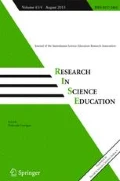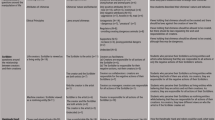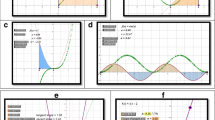Abstract
Conceptualizing and understanding global, physical systems like Earth’s ocean is challenging. Data visualizations on touch-based technology allow learners to explore systems and facilitate embodied experiences, promoting deeper understanding. We investigated how direct manipulation of data visualizations on a touchscreen table affords meaningful learning of science concepts and practices. Using a conceptual framework informed by embodied cognition and sociocultural theory, we analyzed the use of an application displaying global ocean temperature visualizations. Eleven adult-child groups of two to four participants used a think-aloud procedure during four tasks in a lab setting. We recorded, transcribed, and qualitatively coded resulting utterances, looking for evidence of concepts and practices, group meaning-making, and language that could point to embodied cognition. Participants discussed science content and engaged in scientific practices such as describing patterns and refining ideas. Participants used ontological, orientational, and metonymic conceptual metaphors. We discuss implications and provide suggestions for data visualizations on touch platforms.

Similar content being viewed by others
References
Al Kabary, I., Buchler, M., & Schuldt, H. (2013). TOUCHify: Bringing pen-based touch screen functionality to flat panel display screens. International Conference on Information Society (i-Society), 111–116. Toronto, Ontario, Canada: IEEE Press.
Ausubel, D. P. (1968). Educational psychology: A cognitive view. New York: Holt, Rinehart & Winston.
Barab, S. (2006). Design-based research: a methodological toolkit for the learning scientist. In R. K. Sawyer (Ed.), The Cambridge handbook of: The learning sciences (pp. 153–169).
Börner, K., Bueckle, A., & Ginda, M. (2019). Data visualization literacy: Definitions, conceptual frameworks, exercises, and assessments. Proceedings of the National Academy of Sciences, 116(6), 1857–1864.
Cook, J., Lewandowsky, S., & Ecker, U. K. H. (2017). Neutralizing misinformation through inoculation: exposing misleading argumentation techniques reduces their influence. PLoS One, 12(5), e0175799.
Feinstein, N. W., Allen, S., & Jenkins, E. (2013). Outside the pipeline: Reimagining science education for nonscientists. Science, 340(6130), 314–317.
Geerdts, M. S. (2016). (un)real animals: anthropomorphism and early learning about animals. Child Development Perspectives, 10(1), 10–14. https://doi.org/10.1111/cdep.12153.
Greenberg, S., Carpendale, S., Marquardt, N., & Buxton, W. (Eds.). (2012). Sketching user experiences. Amsterdam; Boston: Elsevier/Morgan Kaufmann.
Gutwill, J. P., & Dancstep, T. (2017). Boosting metacognition in science museums: simple exhibit label designs to enhance learning. Visitor Studies, 20(1), 72–88. https://doi.org/10.1080/10645578.2017.1297132.
Haley Goldman, K., Kessler, C., & Danter, E. (2010). Science on a sphere: cross-site summative evaluation. http://www.oesd.noaa.gov/network/SOS_evals/SOS_Final_Summative_Report.pdf. Accessed 26 Oct 2020.
Harris, A., Rick, J., Bonnett, V., Yuill, N., Fleck, R., Marshall, P., & Rogers, Y. (2009). Around the table: are multiple-touch surfaces better than single-touch for children’s collaborative interactions? Proceedings of the International Conference on Computer-Supported Collaborative Learning, 335–344.
Hmelo, C. E., Holton, D. L., & Kolodner, J. L. (2000). Designing to learn about complex systems. Journal of the Learning Sciences, 9(3), 247–298. https://doi.org/10.1207/S15327809JLS0903_2.
Hohenstein, J., & Tran, L. U. (2007). Use of questions in exhibit labels to generate explanatory conversation among science museum visitors. International Journal of Science Education, 29(12), 1557–1580.
Horn, M., Atrash Leong, Z., Block, F., Diamond, J., Evans, E. M., Phillips, B., & Shen, C. (2012). Of BATs and APEs: An interactive tabletop game for natural history museums. Proceedings of the ACM SIGCHI Conference on Human Factors in Computing Systems, 2059–2068.
Kallery, M., & Psillos, D. (2004). Anthropomorphism and animism in early years science: Why teachers use them, how they conceptualise them and what are their views on their use. Research in Science Education, 34(3), 291–311. https://doi.org/10.1023/B:RISE.0000044613.64634.03.
Klucevsek, K. (2017). The intersection of information and science literacy. Communications in Information Literacy, 11(2), 354–365. https://doi.org/10.15760/comminfolit.2017.11.2.7.
Lakoff, G., & Johnson, M. (2003). Metaphors we live by. Chicago: University of Chicago Press.
Ma, J., Liao, I., Ma, K. L., & Frazier, J. (2012). Living liquid: design and evaluation of an exploratory visualization tool for museum visitors. IEEE Transactions on Visualization and Computer Graphics, 18(12), 2799–2808. https://doi.org/10.1109/TVCG.2012.244.
Malik, S., Ranjan, A., & Balakrishnan, R. (2005). Interacting with large displays from a distance with vision-tracked multi-finger gestural input. Proceedings of the ACM Symposium on User Interface Software and Technology, 43–52. https://doi.org/10.1145/1095034.1095042.
Miles, M. B., & Huberman, A. M. (1994). Qualitative data analysis: An expanded sourcebook (2nd ed.). Thousand Oaks: Sage Publications.
NGSS Lead States. (2013). Next generation science standards: for states, by States. Retrieved from The National Academies Press website: http://www.nextgenscience.org/next-generation-science-standards
Ornek, F. (2008). Models in science education: applications of models in learning and teaching science. Science Education, 3(2), 35–45.
Phipps, M. (2010). Research trends and findings from a decade (1997–2007) of research on informal science education and free-choice science learning. Visitor Studies, 13(1), 3–22.
Roschelle, J. M., Pea, R. D., Hoadley, C. M., Gordin, D. N., & Means, B. M. (2000). Changing how and what children learn in school with computer-based technologies. The Future of Children, 10(2), 76–101.
Schollaert Uz, S., Ackerman, W., O’Leary, J., Culbertson, B., Rowley, P., & Arkin, P. A. (2014). The effectiveness of Science on a Sphere stories to improve climate literacy among the general public. Journal of Geoscience Education, 62(3), 485–494. https://doi.org/10.5408/13-075.1.
Segal, A. (2011). Do gestural interfaces promote thinking? Embodied interaction: congruent gestures and direct touch promote performance in math (doctoral dissertation). Columbia University, New York.
Shaer, O., Strait, M., Valdes, C., Feng, T., Lintz, M., & Wang, H. (2011). Enhancing genomic learning through tabletop interaction. Proceedings of the ACM SIGCHI Conference on Human Factors in Computing Systems, 2817–2826. https://doi.org/10.1145/1978942.1979361.
Soni, N., Darrow, A., Luc, A., Gleaves, S., Schuman, C., Neff, H., Chang, P., Kirkland, B., Alexandre, J., Morales, A., Stofer, K. A., & Anthony, L. (2019). Analysis of touchscreen interactive gestures during embodied cognition in collaborative tabletop science learning experiences. Proceedings of the International Conference on Computer Supported Collaborative Learning (CSCL’ 2019), 1, 9–16.
Stofer, K. A. (2016). When a picture isn’t worth 1000 words: learners struggle to find meaning in data visualizations. Journal of Geoscience Education, 64(3), 231–241. https://doi.org/10.5408/14-053.1.
Vygotsky, L. (1978). Mind in society: The development of higher mental processes. Cambridge: Harvard University Press.
Wilson, A. D., & Golonka, S. (2013). Embodied cognition is not what you think it is. Cognitive Science, 4, 58.
Acknowledgments
We thank Gina Hillsberry and Jessica Childers for manuscript review and formatting, and our anonymous reviewers and editors for their feedback on the manuscript. We also thank all of our participants for their contributions and our advisory board for their continued insight.
Data, Code, and Materials Availability
Data, code, and study materials will be available on Open Science Framework https://osf.io/rjzkh/ or by request as ethics board review requires.
Funding
This work was supported by the National Science Foundation under grant number 1612485.
Author information
Authors and Affiliations
Contributions
Carrie Schuman coordinated embodied cognition data analysis and led writing. Kathryn Stofer is the project principal investigator, led overall project design, supervised education researchers, and supervised writing. Lisa Anthony is the project co-principal investigator, led the overall project design with Kathryn Stofer, and supervised the prototype design and the computer science researchers.. Hannah Neff contributed to the study’s design, execution, data analysis and writing. Peter Chang contributed to the design of the embodied cognition analysis and the data analysis itself. Nikita Soni contributed to the design and development of the prototype application, designing and conducting the research study, and data analysis for the study. Alice Darrow contributed to the design and development of the prototype application, the design and conduct of the research study, and data analysis. Annie Luc contributed to prototype design and development and research study design and conduct. Amanda Morales contributed to the design and implementation of the research study. Jeremy Alexandreparticipated in data analysis of the science content and practices. Brittani Kirkland led the original development of the codebook for science content and practices.
Corresponding author
Ethics declarations
Conflict of Interest
The authors declare that they have no conflict of interest.
Additional information
Publisher’s Note
Springer Nature remains neutral with regard to jurisdictional claims in published maps and institutional affiliations.
Rights and permissions
About this article
Cite this article
Schuman, C., Stofer, K.A., Anthony, L. et al. Ocean Data Visualization on a Touchtable Demonstrates Group Content Learning, Science Practices Use, and Potential Embodied Cognition. Res Sci Educ 52, 445–457 (2022). https://doi.org/10.1007/s11165-020-09951-9
Published:
Issue Date:
DOI: https://doi.org/10.1007/s11165-020-09951-9




